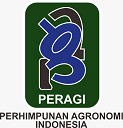Growth Response of Aromatic Grasses to Soil Salinity Stress
Abstract
This research aims to determine the growth response of vetiver, lemongrass and citronella plants in terms most resistant to soil salinity stress levels. The study was carried out at the screen house of the Faculty of Agriculture, Santo Thomas Catholic University, Medan, which is 32 meters above sea level. This research was carried out in January to March 2024. The study used a factorial, Completely Randomized Design, which consisted of two factors. The first factor is the influence of several aromatic grasses (R), which consist of 3 types: lemongrass, citronella, and vetiver. The second factor is the salinity soil stress (S) level, which consists of five levels: without saline, 25% saline soil, 50% saline soil, 75% saline soil saline, and 100% saline soil. Based on these treatment combinations, there were 15 combinations, and each treatment was repeated 3 times so that 45 plants/pots measured 5L. Parameter observations were carried out during harvesting; the parameters observed were shoot fresh weight, shoot dry weight, root fresh weight, root volume, and root cross-section anatomy. The results of the study can be stated that the factor of several aromatic grasses has a significant effect on shoot fresh weight, shoot dry weight, roots fresh weight, and roots volume, where the best aromatic grasses is vetiver even though it was not significantly different from citronella which is resistant to growth at salinity stress levels of 50% to 100%. The salinity level also has a significant effect where salinity starting from 25% causes a decrease in the fresh weight and dry weight of the shoot of the three aromatic grasses.
Keywords
Full Text:
PDFReferences
Achmad, R., Dariah, A., & Sutono, S. (2018). Pengelolaan Sawah Salin Berkadar Garam Tinggi. In IAARD PRESS (Vol. 11, Issue 1).
Alabdallah, N. M., Saleem, K., Al-Shammari, A. S., AlZahrani, S. S., Javed, H. H., Raza, A., Asghar, M. A., & Yong, J. W. H. (2024). Dose-dependent regulation of morphological, physio-biochemical, nutritional, and metabolic responses by cobalt in Tagestes erecta L. plants exposed to salinity stress. Plant Stress, 13(April), 100507. https://doi.org/10.1016/j.stress.2024.100507
Angon, P. B., Mondal, S., Akter, S., Sakil, M. A., & Jalil, M. A. (2023). Roles of CRISPR to mitigate drought and salinity stresses on plants. Plant Stress, 8(May), 100169. https://doi.org/10.1016/j.stress.2023.100169
Dannoura, M., Epron, D., Desalme, D., Massonnet, C., Tsuji, S., Plain, C., Priault, P., & Gérant, D. (2018). The impact of prolonged drought on phloem anatomy and phloem transport in young beech trees. Tree Physiology, 39(2), 201–210. https://doi.org/10.1093/treephys/tpy070
Edelstein, M., Plaut, Z., Dudai, N., & Ben-Hur, M. (2009). Vetiver (Vetiveria zizanioides) responses to fertilization and salinity under irrigation conditions. Journal of Environmental Management, 91(1), 215–221. https://doi.org/10.1016/j.jenvman.2009.08.006
Kim, H. K., Park, J., & Hwang, I. (2014). Investigating water transport through the xylem network in vascular plants. Journal of Experimental Botany, 65(7), 1895–1904. https://doi.org/10.1093/jxb/eru075
Kristianto, P. and T. (2013). 225850-Respons-Tanaman-Kedelai-Kacang-Tanah-Dan-13900Cfe. 26, 45–60.
Kusmiyati, F., Sumarsono, & Karno. (2014). Pengaruh Perbaikan Tanah Salin Terhadap Karakter Fisiologis Calopogonium Mucunoides. Pastura, 4(1), 1–6.
Liang, K., Chen, Y., Hou, J., Yan, F., & Liu, F. (2024). ABA-mediated stomatal response modulates the effects of drought, salinity and combined stress on tomato plants grown under elevated CO2. Environmental and Experimental Botany, 223(April), 105797. https://doi.org/10.1016/j.envexpbot.2024.105797
Loudari, A., Mayane, A., Naciri, R., Zeroual, Y., Colinet, G., & Oukarroum, A. (2022). Root morphological and anatomical responses to increasing phosphorus concentration of wheat plants grown under salinity. Plant Stress, 6(October), 100121. https://doi.org/10.1016/j.stress.2022.100121
Minhas, P. S., Ramos, T. B., Ben-Gal, A., & Pereira, L. S. (2020). Coping with salinity in irrigated agriculture: Crop evapotranspiration and water management issues. Agricultural Water Management, 227(May 2019), 105832. https://doi.org/10.1016/j.agwat.2019.105832
Nazari, M., Ghasemi-Soloklui, A. A., Kordrostami, M., & Abdel Latef, A. A. H. (2023). Deciphering the response of medicinal plants to abiotic stressors: A focus on drought and salinity. Plant Stress, 10(October), 100255. https://doi.org/10.1016/j.stress.2023.100255
Novita, A., Julia, H., & Rahmawati, N. (2019). Tanggap Salinitas Terhadap Pertumbuhan Bibit Akar Wangi ( Vetiveria zizanioides L .). Agrica Ektensia, 13(2), 55–58.
Othman, Y. A., Hani, M. B., Ayad, J. Y., & St Hilaire, R. (2023). Salinity level influenced morpho-physiology and nutrient uptake of young citrus rootstocks. Heliyon, 9(2), e13336. https://doi.org/10.1016/j.heliyon.2023.e13336
Pandey, V. C., Rai, A., & Korstad, J. (2019). Aromatic Crops in Phytoremediation. In Phytomanagement of Polluted Sites: Market Opportunities in Sustainable Phytoremediation. Elsevier Inc. https://doi.org/10.1016/B978-0-12-813912-7.00009-0
Rasool, A., Shah, W. H., Mushtaq, N. U., Saleem, S., Hakeem, K. R., & ul Rehman, R. (2022). Amelioration of salinity induced damage in plants by selenium application: A review. South African Journal of Botany, 147, 98–105. https://doi.org/10.1016/j.sajb.2021.12.029
Saranya, K., Sundaramanickam, A., Manupoori, S., & Kanth, S. V. (2022). Screening of multi-faceted phosphate-solubilising bacterium from seagrass meadow and their plant growth promotion under saline stress condition. Microbiological Research, 261(May), 127080. https://doi.org/10.1016/j.micres.2022.127080
Sarvade, S., Gautam, D. S., Kathal, D., & Tiwari, P. (2017). Waterlogged wasteland treatment through agro-forestry: A review. Journal of Applied and Natural Science, 9(1), 44–50. https://doi.org/10.31018/jans.v9i1.1147
Segarra-Medina, C., Alseekh, S., Fernie, A. R., Rambla, J. L., Pérez-Clemente, R. M., Gómez-Cádenas, A., & Zandalinas, S. I. (2023). Abscisic acid promotes plant acclimation to the combination of salinity and high light stress. Plant Physiology and Biochemistry, 203(June). https://doi.org/10.1016/j.plaphy.2023.108008
Silva, E. F. da, Santos, H. R. B., Ometto, J. P. H. B., Jardim, A. M. da R. F., Silva, T. G. F. da, Hermínio, P. J., Simões, A. N., Souza, E., & Ferreira-Silva, S. L. (2024). Salt-excluder rootstock improves physio-biochemical responses of grafted grapevine plants subjected to salinity stress. Current Plant Biology, 37(November 2023). https://doi.org/10.1016/j.cpb.2023.100316
Suryaman, M., Hodiyah, I., & Nuraeni, Y. (2021). Mitigasi Cekaman Salinitas pada Fase Perkecambahan Kedelai melalui Invigorasi dengan Ekstrak Kulit Manggis dan Ekstrak Kunyit. AGROSAINSTEK: Jurnal Ilmu Dan Teknologi Pertanian, 5(1), 18–26. https://doi.org/10.33019/agrosainstek.v5i1.172
Tahjib-Ul-Arif, M., Hasan, M. T., Rahman, M. A., Nuruzzaman, M., Rahman, A. M. S., Hasanuzzaman, M., Haque, M. R., Hossain, M. A., Abdel Latef, A. A. H., Murata, Y., & Brestic, M. (2023). Plant response to combined salinity and waterlogging stress: Current research progress and future prospects. Plant Stress, 7(February), 100137. https://doi.org/10.1016/j.stress.2023.100137
Thakur, R., Sarvade, S., & Dwivedi, B. S. (2022). Heavy Metals: Soil Contamination and Its Remediation. Agriculture Association of Textile Chemical and Critical Reviews Journal, December 2022, 59–76. https://doi.org/10.58321/AATCCReview.2022.10.02.59
Truong, P. (2023). Vetiver Roots the Vetiver System Technology Hidden Half. 13–14.
Xue, F., Liu, W., Cao, H., Song, L., Ji, S., Tong, L., & Ding, R. (2021). Stomatal conductance of tomato leaves is regulated by both abscisic acid and leaf water potential under combined water and salt stress. Physiologia Plantarum, 172(4), 2070–2078. https://doi.org/10.1111/ppl.13441
Yan, N., Wang, W., Mi, T., Zhang, X., Li, X., & Du, G. (2024). Enhancing tomato growth and soil fertility under salinity stress using halotolerant plant growth-promoting rhizobacteria. Plant Stress, 14(September), 100638. https://doi.org/10.1016/j.stress.2024.100638
Refbacks
- There are currently no refbacks.



























